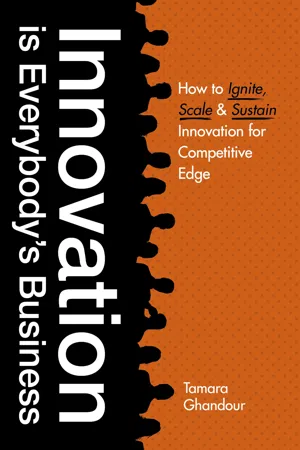![]()
PART I:
DISCOVERING INNOVATION
![]()
Chapter 1
Discovering Innovation
I’ll Never Forget Steve
I wanted nothing more than to work in advertising on Madison Avenue. In 1995, to me, all the great creative work originated on this magical street in the heart of Midtown Manhattan. When I graduated from the University of California at Berkeley, I bought a one-way ticket to the East Coast to make my advertising dreams come true. I landed a job as an account coordinator at the second largest global advertising agency. That meant I was the lowest on the organizational chart and was lucky to make copies or get coffee for my team.
One day, my boss pulled me into her office for what I would consider big news. She put me in charge of the annual meeting—the meeting where the creative strategy was set for the coming year. Everyone who touched the brand had to attend—the clients, the account management team that tracked the numbers, the team that ran the commercial production. Above all, the creative team would be there, with one creative in particular—Steve.
Steve had that creative mojo we all craved. He had multiple “aha” moments daily and wowed us with his creative brilliance. He’d start a sentence with “What if …” followed by a pause; we’d lean in, pens and notepads ready. My job was to pump everyone up to benefit from Steve’s magical genius.
The big day arrives. It’s a 9:00 a.m. start time, but I am there early. Steaming pots of coffee and containers of cream line the counter, markers and sticky notes of various colors litter the big conference table, and easel pads are set up at each end of the room … ready for Steve’s brilliance.
8:45 a.m.: Clients and account management roll in. Energy is high as everyone grabs their first cup of coffee. No Steve. But creatives are never early.
9:00 a.m.: The rest of the advertising team arrives: Jill from accounting, Frank from media buy …. Everyone who touches the brand is chatting away with coffee in hand. Except for Steve. But creatives are never on time.
9:20 a.m.: The energy is fading, and people take their seats. No Steve. But creatives are always late.
9:45 a.m.: Everyone is sitting around the big conference table. The coffee is gone and people settle into their seats. The chatter dies down. No sign of Steve.
I’m instructed to find him, so I start dialing for dollars. I call the production room, the reception desk, every floor in the building. I finally reach him … at home. Why is he at home? I ask him, “Steve why aren’t you here for the big meeting?”
He says, “Oh, I just wasn’t feeling the mojo today, so we’ll need to reschedule that.” And he hung up! My short career flashes before my eyes. I look at the staring faces. I say, “Steve’s not coming, sooooooo …”
A painful silence fills the room as we look around at each other, into space, at the floor. Then, the most amazing thing happens. Jill from accounting speaks up. She says, “I know I just look at the numbers, but I’m seeing this interesting pattern, and it gave me an idea.” Then Frank from media buy says, “I’m seeing some trends with our competitors and it got me thinking about a few ideas.” Before I knew it, the room was bubbling with innovative ideas—without Steve.
That experience set me on an obsessive path to better understand how we innovate. If given the ability and room to innovate, is everyone capable of being an innovator? And, if yes, why bestow special powers upon select people, like Steve, when anyone can unlock their own innovation superpowers?
In my 25+ years of work and research, the answer is crystal clear: Being innovative is built into our brains, our behaviors, and our environment; we just need to ignite it.
Let’s find a new mental model to energize your amazing innovation.
Mental Model of Innovation
To understand a mental model of innovation, you must first understand what a mental model is.
Simply put, a mental model is the way in which you understand the world around you. It gives you a framework for how you think and how you perceive opportunities, challenges, and your beliefs and actions. I like to think of it as apps for your mind. The apps categorize and organize the content of your life, helping you make sense of it all. The apps you have on your phone are a reflection of how you see the world; you decide which ones to download. The same is true for your mental models. You decide the mental models through which you filter the world.
The beauty of mental models is they can be learned and unlearned. In fact, you have probably learned several in your lifetime and discarded a few along the way that didn’t serve you. You might have different mental models for your exercise routine, your work ethos, your religious beliefs, and your relationships. Your mental model in those areas helps you move through your life with more efficiency and decisiveness. The effectiveness of your thinking and actions is directly related to the models in your head. Powerful and effective models will yield powerful and effective results. Weak and self-sabotaging models will yield the opposite.
Mental models come in many shapes and sizes. I have a colleague who always sees the worst in the world. No matter the topic of conversation, she is quick to point out the worst-case scenario or, at a minimum, tell you all the reasons why your idea won’t work. Through her eyes, doom and gloom are right around the corner. Her mental model starts and categorizes the world around her from a negative vantage point. Hence, her beliefs about what’s possible, her words, and her actions reflect this negative mental model. On the other side, I have another colleague who clearly has an opportunistic mental model of the world. For her, there’s an opportunity everywhere she looks, even when we are stuck in rush hour bumper-to-bumper traffic with no way to get off the highway. She’s the first to point out the strengths of your idea and share how you can take advantage of even the most frustrating situation.
What I propose is a powerful mental model of innovation—a model that accepts innovation as a powerful skill everyone embodies. Through our Everyday Innovator Styles, this model includes how you and those around you innovate and tap into unrealized potential. It’s a model that puts the emphasis on the human side of innovation, not the processes and procedures that don’t serve us. It’s a mental model that I’ve seen transform the most unsuspecting people from average to outstanding innovators. You’ll begin to see the world around you through a new lens. That lens will guide your beliefs, mind-set, and actions. Close your eyes and imagine for a moment what the world might look like through this lens. Are you seeing more opportunities, more paths to success? Yes!
This approach to the mental model breaks away from the traditional and ineffective models of the past that assume innovation is like rarefied air, elevating the innovation power to only a select few. The new and improved mental model works because it allows you take on the world through an innovation lens that expands how you see your situation, challenges, and opportunities. You gain the advantage.
I hope you’ll discover how this mental model helps shift the results in your life and taps the power of innovation inside yourself and those around you. Create a model that doesn’t limit you to an external process but an internal framework to help see the world and your place in it differently.
To accept this new model, you’ll need to unlearn a few old models that may be holding you back.
Unlearn to Innovate
I’ll never forget the moment my boss, a petite woman with a love of hierarchy, told me the projects a different team was working on were not my concern and dismissed the sales opportunity I discovered for them. As the most junior person in the company, my idea wasn’t fully fleshed out, but I felt there was something to consider. Eager to present it in the all-team meeting, I raised my hand. Partway through my explanation, my boss cut me off. I left that meeting feeling demoralized and detached when I should have felt valued and appreciated. I went the extra mile on something I didn’t personally benefit from. For the next year, every time I had an idea, I shoved it deep down and didn’t say a word. With that one experience, she made it clear that innovation was not my job responsibility or something I was capable of. Sadly, I believed her … for a short while.
Maybe you are not designated for innovation, but you have ideas. You’ve been frustrated and thought, There has got to be a better way. Have you been told to “stay the course” while others innovate? When you expressed your thoughts, were you encouraged or denigrated?
Most of us have experienced negative consequences, beginning in our childhood, for stepping out and thinking differently. The results of a study about creativity in the classroom found there was an inverse relationship between children ranked by teachers as their favorites and kids they considered creative.1 Even though creativity was seen as highly valued by teachers in this study, creative students were their least favorite. Why do you suppose that was? Imagine 30+ kids in a classroom and the contingent of those who at times don’t follow the rules, make up their own “right” answers, or require different learning approaches than the traditional memorization. Most often, they become disruptive and demanding … or disappear from the classroom.
You learn at an early age there may be punishment for thinking differently. You are encouraged and rewarded for finding the one right answer, not for the thinking process you go through to find that answer. When was the last time you were asked to share your thought process for making a decision, regardless of the impact of the decision? Or, do you remember when you were rewarded for the process you took to land the new client, or were you just rewarded (or punished) for the outcome?
Fear, Comfort, and Constraint
Over time, you believe that being an innovator isn’t for you. You train yourself out of using your natural innovation strengths. They become weak, so when you do try to be innovative, you find it hard and exhausting, only validating that you aren’t the innovative type. The internal chatter starts to hold you back, squelching the internal compass that keeps pointing you to a more innovative path, so you stop trying completely. It’s been my experience that this manifests itself in three main reasons why you don’t innovate even though you know it’s possible and necessary.
Fear
Fear of failure, fear of looking stupid, fear of consequences, fear of the unknown … the fear list is long. What do you fear?
Fear is real. It’s a primal response that your brain uses to keep you from getting hurt. Back in your caveman days, fear is what made you perk up when there was a rustle in the bushes. It could be a tiger coming to eat you. But in today’s modern world, fear plays tricks on you. It keeps you tied to the status quo. Our minds manufacture false fears that unnecessarily put us into flight mode.
Almost five hundred years ago, Michel de Montaigne said it best: “My life has been filled with terrible misfortune; most of which never happened.”
One study showed that 85 percent of what we worry about never comes to fruition.2 That means most of what you fear—a negative response, an epic failure, being perceived as not worthy—never becomes a reality. This noise is your internal chatter holding you back. While the feeling of fear is very real, what we fear often is not.
Feelings of fear will never go away; it’s hardwired into us. It’s why you’ll never hear me tell you to “dare to be fearless.” It’s unrealistic and impossible. It sets you up to fail, especially in the moment when fear creeps in. Then you think, Forget it, I can’t be fearless, and you are right. Fear is part of the human design.
My goal is not to eliminate your fear but to unlock the innovative mind-set you need to embrace it and push through it.
Comfort
It’s easier to stay where you are than to shift to something different. There is comfort in the familiar. Even if you don’t like your current situation, at least you know it and it doesn’t rock the boat.
Take a look at your work and life. How often do you choose to go to a restaurant simply because you could recite the menu back to...



